|
Draft
Declaration on Cities and Other Human Settlements:
|
 |
PARAGRAPHS
42 and 43 (GENDER): NORWAY
(keft and below) stressed the importance of moving the goals
of the Habitat Agenda forward, not backward, then proposed
replacing language on the removal of obstacles and inequalities
with reference to eradicating legal and social barriers. He
noted this was language taken from the Habitat Agenda. |
|
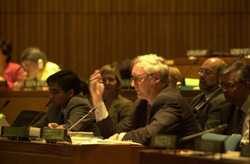 |
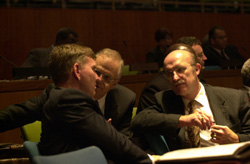 |
Members
of the US delegation (left) are immersed in conversation while
waiting for the meeting to resume |
|
|
| Delegate
from Russia carefully reads the draft text projected on screen |
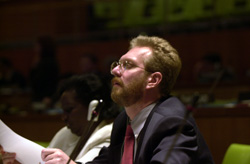 |
|
|
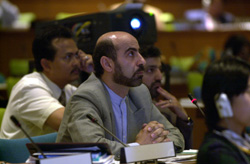 |
PARAGRAPH
8 (REPORTS): Iran (left) on behalf of
G-77/CHINA ( proposed language commending the efforts of the
Executive Director of Habitat, and adding that the reports
are noted in conformity with the legal framework and national
policies of each country. |
|
|
|
|
Thematic
Committee:
|
|
The Secretariat noted that the Rapporteur for the Thematic Committee
was not Laszló Miklós (Slovak Republic) as announced Wednesday,
but his compatriot Elena Szolgayova of the Ministry of Construction
and Regional Development. It was also announced that Vice-Chair
Erna Witoelar (Indonesia) would chair the afternoon session
Right:
View from the back of Conference Room 4, meeting room of
the Thematic Committee
|
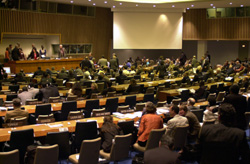 |
|
|
|
NIGERIA: J. O. Okunfulure, Director of Lands, Urban and Regional Development,
and Garba Madaki Ali, Minister of State for Works and Housing,
discussed sustainable urban development and good governance
in Nigeria.
Excerpts
of Okunfulure's presentation 
|
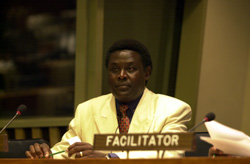 |
|
|
SWEDEN: Mats Pemer, Director of the Strategic Department, Stockholm City Planning
Administration, described the development of Stockholm as
a sustainable compact city, noting a planned growth strategy
since 1952 that provides for good housing, efficient public
transport and reclaimed industrial lands.
Excerpts
of Pemer's responses to delegates' queries |
 |
|
|
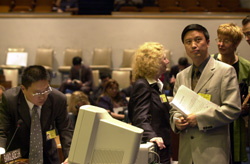 |
Left
photo: Vice Mayor Wang preparing for his presentation |
| CHINA: Shaoxiong Wang (right), Vice Mayor of Chengdu Municipality, introduced
the Fu and Nan Riverbank Refurbishment project as a successful
example of comprehensive urban environmental renovation. He
noted the synergies between public planning and market forces,
and emphasized the importance of the role and support of the
central government. |
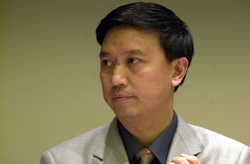 |
|
|
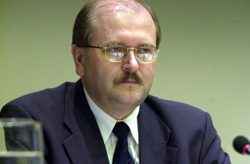 |
POLAND: The Mayor of Katowice (left), Peter Uszok, discussed an environmental
management and city development strategy in Katowice Agglomeration
involving reclamation and rehabilitation of industrial mining
areas. |
|
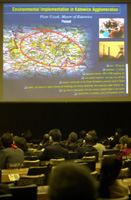
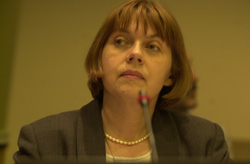 Left:
Participants watching the Polish video on Environmental
Management Left:
Participants watching the Polish video on Environmental
Management
Justina
Gorgon (right) presented the project results and achievements
of the Katowice Agglomeration
Excerpt
from presentation on Katowice Environmental Management 
|
|
|
| BRAZIL: Celso Daniel, Mayor of Santo André, presented an integrated programme
for social inclusion in this area located on the outskirts
of São Paolo. |
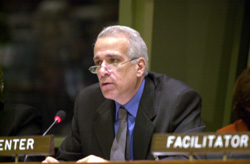 |
| Joaquim
Roriz, Governor of Federal District of Brasilia, spoke about
transformation of the slum areas around Samambaia, where families
were provided the means to relocate to an area where they
could own a plot of land and build their own homes. |
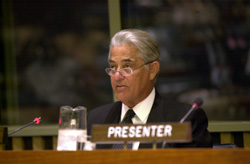 |
|
|
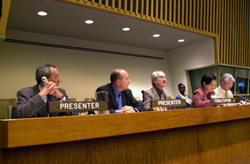 |
FRANCE: Gérard Collomb (below), Mayor of Lyon, described "Millénaire3," his
city's strategy for integrated urban development in the context
of globalization. Left photo: The dias during the presentation
on Lyon |
Excerpt from presentation on Lyon  |
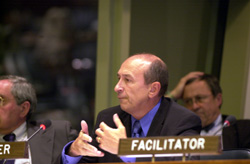 |
|
|
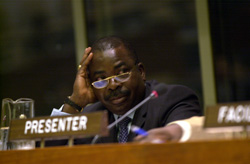 |
NIGERIA: Creation of geopolitical zones to balance regional
growth and development and the establishment of an urban development
bank were among the sweeping initiatives undertaken by the
government in cooperation with the World Bank |
|
|
|
SPAIN: Joan Clos (right), Mayor of Barcelona, discussed sustainable economic
transformation and decentralization in Barcelona. He described
a growth model based on transformation of industrial seafront
areas and revitalization of historic districts through investments
involving joint capital companies and communities
Excerpt
of presentation on Barcelona 
|
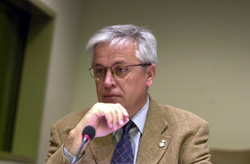 |